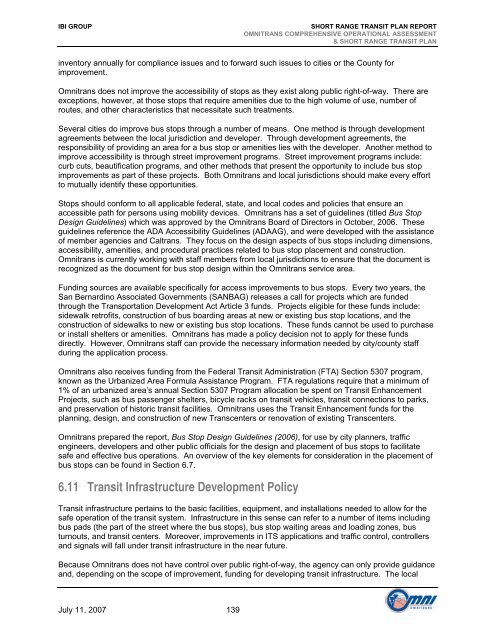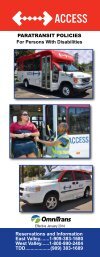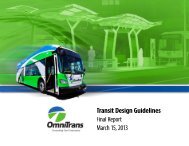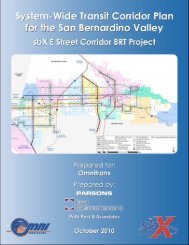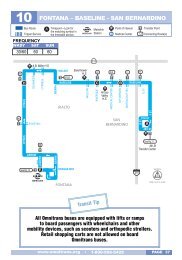Short Range Transit Plan 2008-2013 - Omnitrans
Short Range Transit Plan 2008-2013 - Omnitrans
Short Range Transit Plan 2008-2013 - Omnitrans
You also want an ePaper? Increase the reach of your titles
YUMPU automatically turns print PDFs into web optimized ePapers that Google loves.
IBI GROUP<br />
SHORT RANGE TRANSIT PLAN REPORT<br />
OMNITRANS COMPREHENSIVE OPERATIONAL ASSESSMENT<br />
& SHORT RANGE TRANSIT PLAN<br />
inventory annually for compliance issues and to forward such issues to cities or the County for<br />
improvement.<br />
<strong>Omnitrans</strong> does not improve the accessibility of stops as they exist along public right-of-way. There are<br />
exceptions, however, at those stops that require amenities due to the high volume of use, number of<br />
routes, and other characteristics that necessitate such treatments.<br />
Several cities do improve bus stops through a number of means. One method is through development<br />
agreements between the local jurisdiction and developer. Through development agreements, the<br />
responsibility of providing an area for a bus stop or amenities lies with the developer. Another method to<br />
improve accessibility is through street improvement programs. Street improvement programs include:<br />
curb cuts, beautification programs, and other methods that present the opportunity to include bus stop<br />
improvements as part of these projects. Both <strong>Omnitrans</strong> and local jurisdictions should make every effort<br />
to mutually identify these opportunities.<br />
Stops should conform to all applicable federal, state, and local codes and policies that ensure an<br />
accessible path for persons using mobility devices. <strong>Omnitrans</strong> has a set of guidelines (titled Bus Stop<br />
Design Guidelines) which was approved by the <strong>Omnitrans</strong> Board of Directors in October, 2006. These<br />
guidelines reference the ADA Accessibility Guidelines (ADAAG), and were developed with the assistance<br />
of member agencies and Caltrans. They focus on the design aspects of bus stops including dimensions,<br />
accessibility, amenities, and procedural practices related to bus stop placement and construction.<br />
<strong>Omnitrans</strong> is currently working with staff members from local jurisdictions to ensure that the document is<br />
recognized as the document for bus stop design within the <strong>Omnitrans</strong> service area.<br />
Funding sources are available specifically for access improvements to bus stops. Every two years, the<br />
San Bernardino Associated Governments (SANBAG) releases a call for projects which are funded<br />
through the Transportation Development Act Article 3 funds. Projects eligible for these funds include:<br />
sidewalk retrofits, construction of bus boarding areas at new or existing bus stop locations, and the<br />
construction of sidewalks to new or existing bus stop locations. These funds cannot be used to purchase<br />
or install shelters or amenities. <strong>Omnitrans</strong> has made a policy decision not to apply for these funds<br />
directly. However, <strong>Omnitrans</strong> staff can provide the necessary information needed by city/county staff<br />
during the application process.<br />
<strong>Omnitrans</strong> also receives funding from the Federal <strong>Transit</strong> Administration (FTA) Section 5307 program,<br />
known as the Urbanized Area Formula Assistance Program. FTA regulations require that a minimum of<br />
1% of an urbanized area’s annual Section 5307 Program allocation be spent on <strong>Transit</strong> Enhancement<br />
Projects, such as bus passenger shelters, bicycle racks on transit vehicles, transit connections to parks,<br />
and preservation of historic transit facilities. <strong>Omnitrans</strong> uses the <strong>Transit</strong> Enhancement funds for the<br />
planning, design, and construction of new Transcenters or renovation of existing Transcenters.<br />
<strong>Omnitrans</strong> prepared the report, Bus Stop Design Guidelines (2006), for use by city planners, traffic<br />
engineers, developers and other public officials for the design and placement of bus stops to facilitate<br />
safe and effective bus operations. An overview of the key elements for consideration in the placement of<br />
bus stops can be found in Section 6.7.<br />
6.11 <strong>Transit</strong> Infrastructure Development Policy<br />
<strong>Transit</strong> infrastructure pertains to the basic facilities, equipment, and installations needed to allow for the<br />
safe operation of the transit system. Infrastructure in this sense can refer to a number of items including<br />
bus pads (the part of the street where the bus stops), bus stop waiting areas and loading zones, bus<br />
turnouts, and transit centers. Moreover, improvements in ITS applications and traffic control, controllers<br />
and signals will fall under transit infrastructure in the near future.<br />
Because <strong>Omnitrans</strong> does not have control over public right-of-way, the agency can only provide guidance<br />
and, depending on the scope of improvement, funding for developing transit infrastructure. The local<br />
July 11, 2007 139


